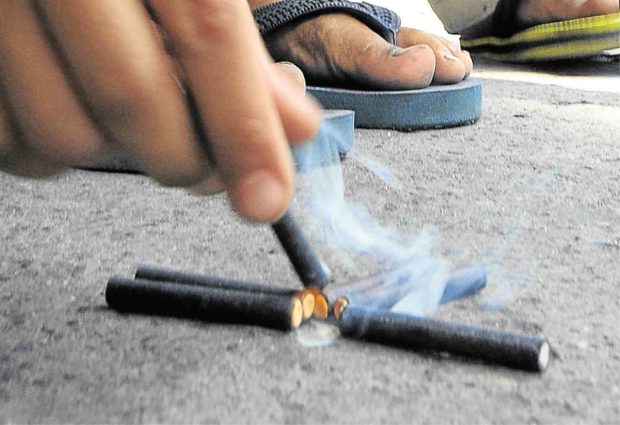
The banned firecracker “piccolo” has been blamed formany blast injuries, especially among children, during the New Year revelry. —INQUIRER FILE PHOTOS
BOCAUE, Bulacan — Smuggled firecrackers like “piccolo” caused some of the blast injuries in the New Year’s Eve revelry, tainting the fireworks industry, according to an official.
Many victims treated before and during New Year’s Day were reportedly hurt by piccolo, a prohibited firecracker similar to “watusi,” a “match firecracker,” or the “scratch banger.”
Piccolo is set off by friction when its user scratches the thin, red device on any surface.
Joven Ong, president of Philippine Fireworks Association, said some smuggled fireworks had been repackaged and sold in the market as products manufactured in Bocaue, although misspelled as “Bukawe.” Other smugglers had labeled piccolo sold in the market as “Pacquiao,” after boxing champion and Sen. Manny Pacquiao.
Ong said the local fireworks trade was uncertain how piccolo continued to penetrate the market, with some of these reportedly sold in small outlets at Divisoria in Manila.
During the years when their sale was tolerated, smuggled firecrackers amounted to an equivalent of 200 containers, he said.
“We sound like a broken record when it comes to smuggling. We must ensure that we penalize these violators and double the penalty for public officials [who tolerate smuggling],” said Sen. Joel Villanueva, who led the “Pailaw Pasasalamat” fireworks display here on Monday night.
“I think we should offer safer alternatives to piccolo that can be produced by local firecracker makers. I am in favor of sparklers since these do not explode,” he said.
“Professional pyrotechnics exhibitions using licensed firecrackers are also preferable since children get to enjoy fireworks without risking injury,” he said.
“The right thing to do is stop piccolo, prevent them from being smuggled here. Guard our ports. Then the Department of Trade and Industry has to be strict in making sure all fireworks subscribe to standards testing before these are allowed to be sold,” he said.
Local producers have been competing with imported fireworks that may also account for the reported dip in their sales.
Many traders have blamed slow sales on Executive Order (EO) No. 28 that requires all firecrackers to be used only in safe zones, and encourages community fireworks displays.
But Ong said EO 28 was “a good compromise between the industry and public safety” because it did not ban firecrackers and fireworks.
The number of blast victims continued to rise in Central Luzon, from 149 on Tuesday to 190 on Wednesday due to piccolo and “kwitis” (skyrockets), according to the Department of Health.
But the number was still 64 percent lower than the 529 cases recorded from Dec. 22, 2016, to Jan. 3.
In Ilocos Norte province, eight victims were reported, among them a construction worker at Vintar town who had to be treated for an ear injury, and a man from Pasuquin town whose right hand was burned when a piccolo he picked up exploded. —REPORTS FROM CARMELA REYES-ESTROPE, TONETTE OREJAS AND LEILANIE ADRIANO